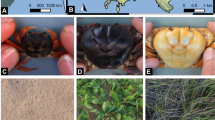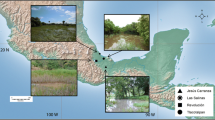Abstract
Coconut crabs (Birgus latro) are strikingly variable in coloration, but the significance of this colour diversity has never been investigated. We studied coloration, morphology, behaviour and background matching of adult coconut crabs, the world’s largest terrestrial invertebrate, at the western edge of its distribution on Pemba Island, Tanzania. Adults are evidently polymorphic; they come in red and blue types (3:1 ratio on Pemba). The best predictor of colour morph was ventral hue, which, using a discriminant function analysis, correctly classified 96% of the crabs assigned into a predefined colour group. In contrast, principal component analyses suggested a degree of overlapping colour variation. We found no evidence that coloration was sex or size-linked. Males were larger than females and the Pemba adult population appeared male-biased (3:1). We also report that red adults may match the background better than do blue adults on land, whereas blue match better near shore than do red. We postulate that although colour diversity in coconut crabs may be genetically determined, potentially through a crustacyanin gene polymorphism influencing the stability of integument pigmentation, its maintenance may involve several ecological drivers.



Similar content being viewed by others
References
Abuhagr AM, Blindert JL, Nimitkul S, Zander IA, Labere SM, Chang SA, Maclea KS, Chang ES, Mykles DL (2014) Molt regulation in green and red color morphs of the crab Carcinus maenas: gene expression of molt-inhibiting hormone signaling components. J Exp Biol 217:796–808
Amesbury S (1980) Biological studies on the coconut crab (Birgus latro) in the Mariana Islands. Agricultural Experiment Station, College of Agriculture and Life Sciences, University of Guam
Barbosa A, Mäthger LM, Buresch KC, Kelly J, Chubb C, Chiao CC, Hanlon RT (2008) Cuttlefish camouflage: the effects of substrate contrast and size in evoking uniform, mottle or disruptive body patterns. Vis Res 48:1242–1253
Bedini R (2002) Colour change and mimicry from juvenile to adult: Xantho poressa (Olivi, 1792) (Brachyura, Portunidae). Crustaceana 75:703–710
Begum S, Cianci M, Durbeej B, Falklöf O, Hädener A, Helliwell JR, Helliwell M, Regan AC, Ian C, Watt F (2015) On the origin and variation of colors in lobster carapace. Phys Chem Chem Phys 17:16723–16732
Bolton PE, Rollins LA, Griffith SC (2015) The danger within: the role of genetic, behavioural and ecological factors in population persistence of colour polymorphic species. Mol Ecol 24:2907–2915
Brown IW, Fielder DR (1991) The Coconut Crab: aspects of the biology and ecology of Birgus latro in the Republic of Vanuatu. ACIAR Monogr 8:136
Caro T, Sherratt TN, Stevens M (2016) The ecology of multiple colour defences. Evol Ecol 30:797–809
Chiao CC, Chubb C, Buresch K, Siemann L, Hanlon RT (2009) The scaling effects of substrate texture on camouflage patterning in cuttlefish. Vis Res 49:1647–1656
Cianci M, Rizkallah PJ, Olczak A, Raftery J, Chayen NE, Zagalsky PF, Helliwell JR (2002) The molecular basis of the coloration mechanism in lobster shell: B-Crustacyanin at 3.2-Å resolution. Proc Natl Acad Sci 99:9795–9800
Cote J, Le Galliard JF, Rossi JM, Fitze PS (2008) Environmentally induced changes in carotenoid-based coloration of female lizards: a comment on Vercken et al. J Evol Biol 21:1165–1172
Detto T, Backwell PRY (2009) The fiddler crab Uca mjoebergi uses ultraviolet cues in mate choice but not aggressive interactions. Anim Behav 78:407–411
Detto T, Hemmi JM, Backwell PRY (2008) Colouration and colour changes of the fiddler crab, Uca capricornis: a descriptive study. PLoS ONE 3:e1629
DeWitt TJ, Sih A, Wilson DS (1998) Costs and limits of phenotypic plasticity. Trends Ecol Evol 13:77–81
Drew MM, Harzsch S, Stensmyr M, Erland S, Hansson BS (2010) A review of the biology and ecology of the robber crab, Birgus latro (Linnaeus, 1767) (Anomura: Coenobitidae). Zool Anz 249:45–67
Endler JA (1983) Natural and sexual selection on color patterns in poeciliid fishes. Environ Biol Fishes 9:173–190
Endler JA (1984) Progressive background in moths, and a quantitative measure of crypsis. Biol J Lin Soc 22:187–231
Endler JA (1991) Variation in the appearance of guppy color patterns to guppies and their predators under different visual conditions. Vis Res 31:587–608
Endler JA (1992) Signals, signal conditions, and the direction of evolution. Am Nat 139:S125–S153
Fisher RA (1930) The genetical theory of natural selection: a complete, variorum edn. Oxford University Press, Oxford
Fletcher W (1969) Coconut crabs. The Sciences 9:26–27
Fletcher WJ, Brown IW, Fielder DR (1990) Movement of coconut crabs, Birgus latro, in a rainforest habitat in Vanuatu. Pac Sci 44:407–416
Ford EB (1945) Polymorphism. Biol Rev 20:73–88
Ford EB (1965) Genetic polymorphism. Faber and Faber Limited, London
Fusco G, Minelli A (2010) Phenotypic plasticity in development and evolution: facts and concepts. Introduction. Philos Trans R Soc B Biol Sci 365:547–556
Gordon SP, López-Sepulcre A, Reznick DN (2011) Predation-associated differences in sex linkage of wild guppy coloration. Evolution 66:912–918
Gray SM, McKinnon JS (2007) Linking color polymorphism maintenance and speciation. Trends Ecol Evol 22:71–79
Green JP (1964) Morphological color change in the fiddler crab, Uca pugnax (S. I. Smith). Biol Bull 127:239–255
Hanlon R, Chiao C-C, Mathger L, Barbosa A, Buresch K, Chubb C (2009) Cephalopod dynamic camouflage: bridging the continuum between background matching and disruptive coloration. Philos Trans R Soc B Biol Sci 364:429–437
Helfman GS (1977) Agonistic behaviour of the coconut crab, Birgus latro (L.). Ethology 438:425–438
Huberty CJ, Olejnik S (2006) Applied MANOVA and discriminant analysis, 2nd edn. Wiley-Interscience, New York
Huxley J (1955) Morphism and evolution. Heredity 9:1–52
Kelber A, Vorobyev M, Osorio D (2003) Animal colour vision—behavioural tests and physiological concepts. Biol Rev Camb Philos Soc 78:81–118
Komdeur J, Oorebeek M, van Overveld T, Cuthill IC (2005) Mutual ornamentation, age, and reproductive performance in the European starling. Behav Ecol 16(4):805–817
Küttner E, Parsons KJ, Easton AA, Skúlason S, Danzmann RG, Ferguson MM (2014) Hidden genetic variation evolves with ecological specialization: the genetic basis of phenotypic plasticity in Arctic charr ecomorphs. Evolut Dev 16:247–257
Lavery S, Moritz C, Fielder DR (1995) Changing patterns of population structure and gene flow at different spatial scales in Birgus latro (the coconut crab). Heredity 74:531–541
Liefting MA, Hoffmann A, Ellers J (2009) Plasticity versus environmental canalization: population differences in thermal responses along a latitudinal gradient in Drosophila serrata. Evolution 63:1954–1963
Lind O, Kelber A (2009) The intensity threshold of colour vision in two species of parrot. J Exp Biol 212:3693–3699
Mateus AR, Marques-Pita M, Oostra V, Lafuente E, Brakefield PM, Zwaan BJ, Beldade P (2014) Adaptive developmental plasticity: compartmentalized responses to environmental cues and to corresponding internal signals provide phenotypic flexibility. BMC Biol 12:97
McGaw IJ, Kaiser MJ, Naylor E, Hughes RN (1992) Intraspecific morphological variation related to the molt-cycle in color forms of the shore crab Carcinus maenas. J Zool 228:351–359
McKinnon JS, Pierotti MER (2010) Colour polymorphism and correlated characters: genetic mechanisms and evolution. Mol Ecol 19:5101–5125
McLean CA, Stuart-Fox D (2014) Geographic variation in animal colour polymorphisms and its role in speciation. Biol Rev 89(4):860–873
Nokelainen O, Lindstedt C, Mappes J (2013) Environment-mediated morph-linked immune and life-history responses in the aposematic wood tiger moth. J Anim Ecol 82:653–662
Oka S, Tomita T, Miyamoto K (2016) A mighty claw: pinching force of the coconut crab, the largest terrestrial crustacean. PLoS ONE 11:e0166108
Olendorf R, Rodd FH, Punzalan D, Houde AE, Hurt C, Reznick DN, Hughes KA (2006) Frequency-dependent survival in natural guppy populations. Nature 441:633–636
Paterson JE, Blouin-Demers G (2017) Distinguishing discrete polymorphism from continuous variation in throat colour of tree lizards, Urosaurus ornatus. Biol J Lin Soc 121:72–81
Price TD (2017) Sensory drive, color, and color vision. Am Nat 190:000-000
Reid DG, Abello P, Kaiser MJ, Warman CG (1997) Carapace colour, inter-moult duration and the behavioral and physiological ecology of the shore crab Carcinus maenas. Estuar Coast Shelf Sci 44:203–211
Robertson JD (1960) Ionic regulation in the crab Carcinus maenas (L.) in relation to the moulting cycle. Comp Biochem Physiol 1:183–212
Rowland HM, Speed MP, Ruxton GD, Edmunds M, Stevens M, Harvey IF (2007) Countershading enhances cryptic protection: an experiment with wild birds and artificial prey. Anim Behav 74:1249–1258
Scheiner SM (1993) Genetics and evolution of phenotypic plasticity. Annu Rev Ecol Syst 24:35–68
Stevens M (2007) Predator perception and the interrelation between different forms of protective coloration. Proc R Soc B Biol Sci 274:1457–1464
Stevens M, Párraga CA, Cuthill IC, Partridge JC, Troscianko TS (2007) Using digital photography to study animal coloration. Biol J Lin Soc 90:211–237
Stevens M, Lown AE, Wood LE (2014) Color change and camouflage in juvenile shore crabs Carcinus maenas. Front Ecol Evol 2:14
Stoddard MC, Stevens M (2010) Pattern mimicry of host eggs by the common cuckoo, as seen through a bird’s eye. Proc R Soc B Biol Sci 277:1387–1393
Styrishave B, Rewitz K, Andersen O (2004) Frequency of moulting by shore crabs Carcinus maenas (L.) changes their colour and their success in mating and physiological performance. J Exp Mar Biol Ecol 313:317–336
Svensson E, Sinervo B, Comendant T (2001) Condition, genotype-by-environment interaction, and correlational selection in lizard life-history morphs. Evolution 55:2053–2069
Thayer AH (1896) The law which underlies protective coloration. Auk 13:477–482
Todd PA, Qiu W, Chong KY (2009) Ontogenetic shifts in carapace patterning and/or colouration in intertidal and subtidal brachyuran crabs. Raffles Bull Zool 57:543–550
Troscianko J, Stevens M (2015) Image calibration and analysis toolbox—a free software suite for objectively measuring reflectance, colour and pattern. Methods Ecol Evol 6:1320–1331
R Core Team (2015) R: a language and environment for statistical computing. R Foundation for Statistical Computing, Vienna, Austria. http://www.R-project.org/
Van Dyck H, Wiklund C (2002) Seasonal butterfly design: morphological plasticity among three developmental pathways relative to sex, flight and thermoregulation. J Evol Biol 15:216–225
Vercken E, Massot M, Sinervo B, Clobert J (2007) Colour variation and alternative reproductive strategies in females of the common lizard Lacerta vivipara. J Evol Biol 20:221–232
Wade NM, Tollenaere A, Hall MR, Degnan BM (2009) Evolution of a novel carotenoid-binding protein responsible for crustacean shell color. Mol Biol Evol 26:1851–1864
West-Eberhard MJ (1989) Phenotypic plasticity and the origins of diversity. Annu Rev Ecol Syst 20:249–278
Windig JJ, Brakefield PM, Reitsma N, Wilson JGM (1994) Seasonal polyphenism in the wild: survey of wing patterns in five species of Bicyclus butterflies in Malawi. Ecol Entomol 19:285–298
Acknowledgements
We thank the Revolutionary Government of Zanzibar for permission; the University of California, Davis for funding fieldwork; and two anonymous reviewers for comments.
Author information
Authors and Affiliations
Corresponding author
Ethics declarations
Conflict of interest
The authors declare that they have no conflict of interest.
Electronic supplementary material
Below is the link to the electronic supplementary material.
Rights and permissions
About this article
Cite this article
Nokelainen, O., Stevens, M. & Caro, T. Colour polymorphism in the coconut crab (Birgus latro). Evol Ecol 32, 75–88 (2018). https://doi.org/10.1007/s10682-017-9924-1
Received:
Accepted:
Published:
Issue Date:
DOI: https://doi.org/10.1007/s10682-017-9924-1




